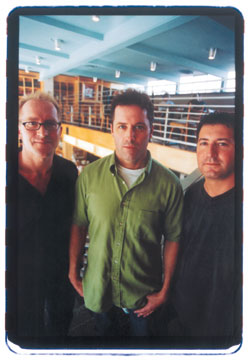They fell in love with the building before they had any use for it. Ten years ago, MARK AND MICHAEL KLEBECK were just getting Bauhaus off the ground, helping anchor the resurgent Pike-Pine corridor. Zeitgeist soon followed downtown, then last year Top Pot on Cap Hill, and just this September their new Top Pot doughnut shop/coffee joint/coffee-roasting/doughnut-making mecca in Belltown. The brothers have partnered with various business types (chiefly Joel Radin) to help run their operations, but these two design-conscious entrepreneurs lend the same clean, uncluttered look to each of their different outlets and enterprises. With Top Pot’s strikingly canted, two-story front window facing west on Fifth, the low September sun stuttering between passing monorails, Mark explains how their goal was “to give the space a timeless feel . . . to maintain the continuity of what the building was.” The 1950 structure was originally used as the showroom for an engineering business and a manufacturing facility for oil burners. Retail in front, factory in backjust like today, only with dough and beans instead of lathes and sheet-metal cutters. As at Zeitgeist and Bauhaus, the Klebecks’ custom-made bookshelves line the walls, here stuffed with encyclopedia sets and books from the ’40s and ’50s. Everything else in the place, from custom-spun aluminum light fixtures (by Matt Shoudy at Illum) to period wooden chairs (found on eBay and re-covered with old, unused rolls of Ford Falcon seat-cover fabric) speaks to the Klebecks’ love for what Mark calls “that vintage corporate aesthetic.” (Think Bakelite phones, Raymond Loewy, and The Hudsucker Proxy.) “Half the stuff we get is salvage,” adds Mark, much of which is storedlike the exterior neon cowboy sign bought in Yakima five years earlierbefore they ever find a use for it. Michael, who installed the terrazzo floors and tread on the floating, L-shaped stairway to the mezzanine level, takes his design cues from old-school buildings and courthousesinstitutional structures meant to last decades, unlike cheap retail spaces regularly revamped to meet the new design breeze: “When we’re done with it, we don’t want it to be the in-vogue place for just this season or for this year.” But while the new Top Pot is solid, streamlined, and hip, it’s not so hip it hurts. While we’re speaking, an older woman wheels in with a walker for a doughnut and some joe, then Stephanie Dorgan, owner of the nearby Crocodile Cafe, stops by to rave about the new space. Here are the two Belltowns embodiedold and new, both of which the Klebecks want to court with cool design and popular prices. That’s the thing: With a Starbucks on every corner, the Klebecks’ whole approach is to get customers to walk that extra block farther for extra design value. Mark concludes, “People have great taste” in Seattleif you only reach out and reward them for taking an interest. Thanks to the Klebecks, more and more people are.BRIAN MILLER Top Pot: 2124 Fifth Ave., 206- 728-1966. MARK AND MICHAEL KLEBECK’S PICKS BEST OLD BUILDING: MarkLenora Square, for its great-big windows and commanding position over Denny. Michael the 1940 U.S. Courthouse on Fifth Avenue, designed by architect Gilbert Stanley Underwood. BEST COOL OLD APARTMENTS: Markthe 1909 Queen Anne High School building. MichaelEl Monterey in the U District. BEST POTENTIAL FOR A MIXED-USE, ARTIST-FRIENDLY URBAN REDEVELOPMENT PROJECT: Markthe Duwamish Waterway and East Marginal Way areas. Michaelthe former Sand Point Naval Air Station. BEST CANDIDATE FOR A COMMERCIAL URBAN RENEWAL PROJECT: Mark and Michaelthe U District, aka “the terror of tiny town.” BEST OLD SEATTLE KITSCH ICON: Michaelthe Hat n’ Boots. BEST RANDOM ARCHITECTURAL EYE-CATCHER: Michaelthe art deco gates to Windermere. BEST OLD BRIDGE: Mark15th Avenue Northeast over the Cowen Park Ravine (particularly the weathered, half-functioning street lamps). BEST NEW BRIDGE: Michaelthe Princeton Street replacement bridge that links Hawthorne Hills to Sand Point Way, because it’s hard to distinguish from the old one. BEST STADIUM: MichaelMemorial Stadium at Seattle Center, for its brutalist-functionalist weathered concrete look. BEST RETRO MAKEOVER RESTAURANT: MarkHattie’s Hat. “You don’t want to be too precious,” he says of both brothers’ generally kitsch-averse sensibility. BEST DESIGNED OLD RESTAURANT: MichaelCanlis, designed in 1950 by Roland Terry. BEST MUSEUM: Michaelthe Seattle Asian Art Museum in Volunteer Park, designed in 1933 by Carl Gould. BEST RESERVOIR/PARK: Markthe Roosevelt Reservoir, for its power-station architecture, which dates to 1910. (“I love the Seattle of that era,” Michael adds.) info@seattleweekly.com
They fell in love with the building before they had any use








